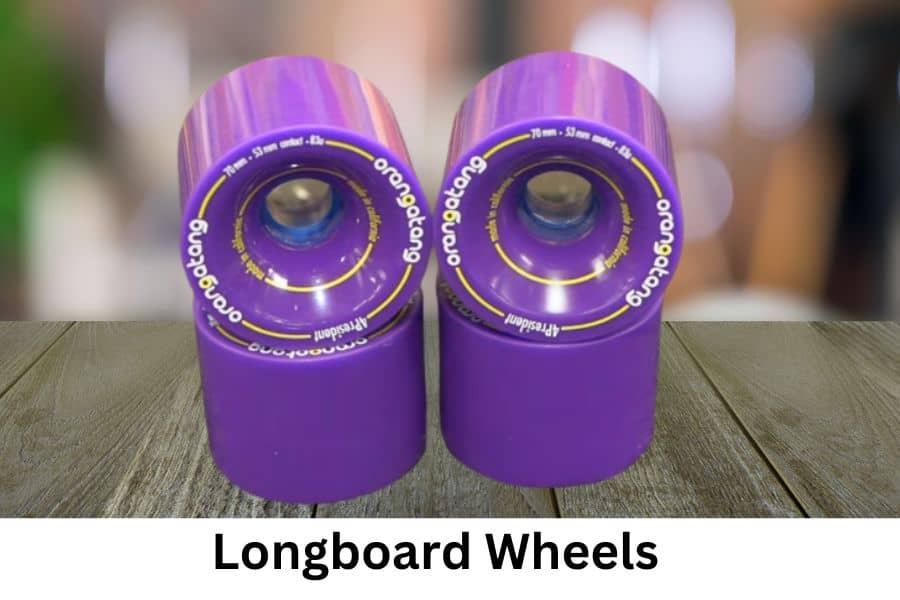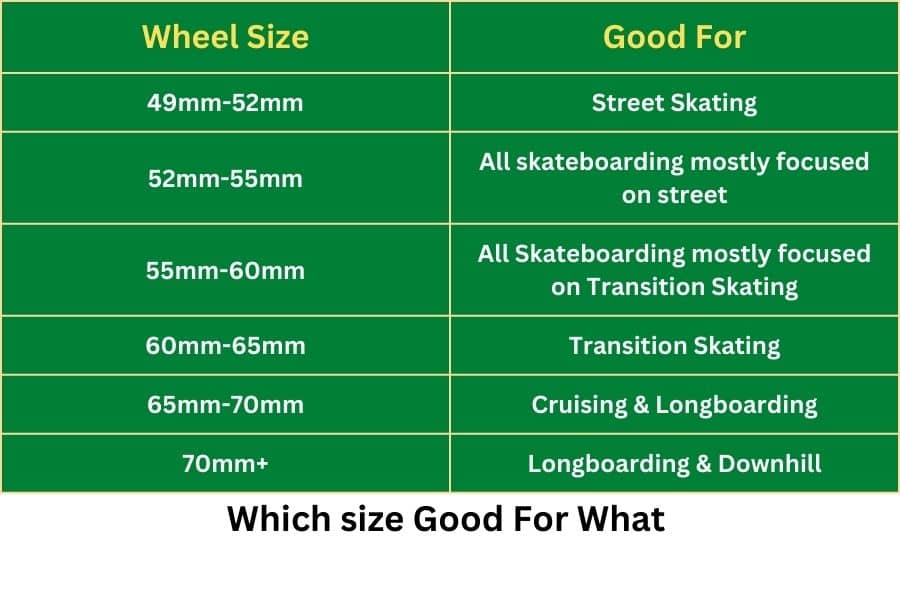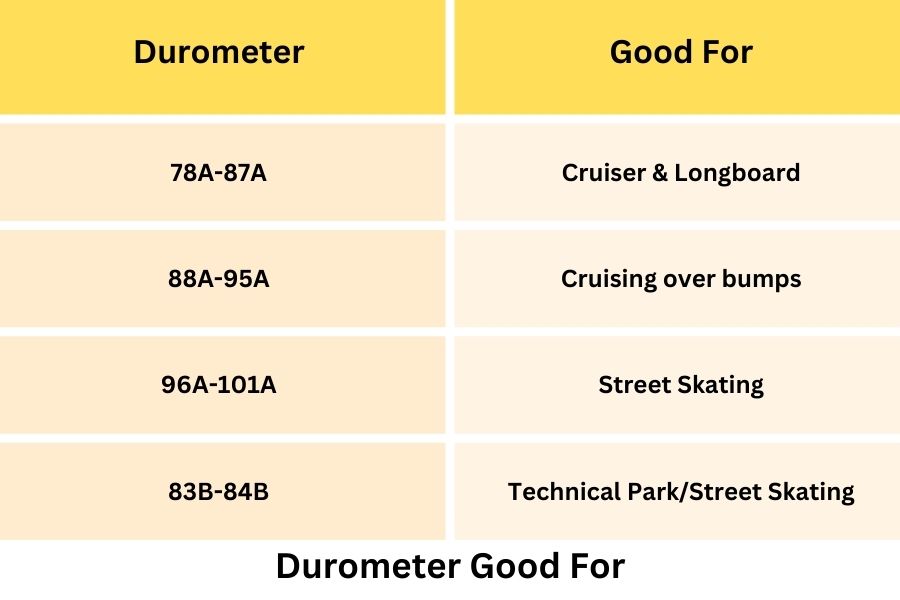Skateboard wheels are among most important parts of skateboard. Wheels are elements on which whole skateboard hovers. Skateboarding, doing tricks, riding in different style all require special wheels. Skateboard wheels have different shape, size, types and other features.
Not all types of wheels are good for all skateboarding style and you also don’t need to buy different wheels for different riding experience. It hears complicated but let me make the matter easy. Lets start with the types of skateboard wheels.

Types Of Wheels
There are basic 3 types of skateboard wheels. They are
- Street wheels
- Cruiser wheels
- Longboard wheels
Street Wheels
Street skateboarding can be challenging, as it requires a high level of skill and precision to perform tricks and navigate obstacles. Riders must have good balance and control over their board, as well as the ability to perform complex maneuvers in tight spaces. It requires a deep understanding of the skateboard and its components specially its wheels because the whole board maneuvers over the wheels.

Street wheels require some features especially to perform street skating. Street wheels need to selected keeping in mind the durometer, size, contact patch and bearings.
Street wheel or park wheels are suitable for riding skateboard in park or street. They are basically harder wheels (95a-101a). On street a rider must ride fast that’s why street wheels must be hard, lightweight and roll faster. Street wheels are also smaller than other wheels. They are suitable for flip tricks, ollies, power-sliding and other tricks.
The standard wheel size for street skateboarding is typically between 50-60mm in diameter. This size range provides a good balance of speed and control, allowing riders to perform a wide variety of tricks and navigate obstacles with ease.
However, it’s worth noting that different riders may prefer slightly different wheel sizes based on their personal preferences and riding style. Some riders may prefer slightly larger wheels for a smoother ride, while others may prefer slightly smaller wheels for more control and stability.
It’s important for each skater to experiment and find the wheel size that works best for them.
Normally soft wheels (78a-90a) are good for cruising. For cruising with skateboard we mean riding skateboard without taking a break. Basically cruising is shredding with skateboard casually & slowly around the city, suburb and neighborhood. Cruiser wheels are slightly bigger than street wheels for smooth riding on uneven surface.
Cruiser Wheel
Cruising skateboard wheels typically range in size from around 50-60mm in diameter. The most common size for cruising is around 54-59mm. Larger wheels (58-60mm) will provide a smoother ride on rough surfaces, while smaller wheels (50-54mm) will be more maneuverable but may not roll as smoothly.

It’s important to note that wheel size is just one factor that can affect a skateboard’s performance, and it’s best to consider the whole setup when selecting wheels for cruising.
The durability of cruising skateboard wheels can vary depending on the quality of the materials used to make the wheel and the conditions they are used in. In general, wheels made from higher-quality materials such as urethane will be more durable and last longer than those made from lower-quality materials.
Additionally, wheels used for cruising on smooth surfaces will typically last longer than those used for more aggressive riding styles.
Longboard Wheels
Longboards are bigger than skateboards in size. Longboard wheels are also bigger than any other wheel types.
To fit with the longboard, longboard wheels typically ranges in size from around 70-75mm in diameter. The most common size for longboarding is around 72-73mm.

Larger wheels (75mm and above) will provide a smoother ride on rough surfaces, while smaller wheels (70-72mm) will be more maneuverable but may not roll as smoothly. The durometer of the wheel also plays a role in the ride quality and sliding ability.
It’s important to note that wheel size is just one factor that can affect a longboard’s performance, and it’s best to consider the whole setup when selecting wheels for longboarding.
Also different types of longboarding require different size wheels, for example, downhill longboarding require larger wheels to maintain speed and grip while freeriding and freestyling require smaller wheels to slide and perform tricks.
The standard and most common durometer for longboard wheels is around 78A-83A, which provides a good balance of grip and slide, making them suitable for general cruising, carving, and sliding.
For sliding and freeriding, wheels with a lower durometer, around 75A-78A, are preferred, as they tend to have more slide and less grip.
For downhill and high-speed riding, wheels with a higher durometer, around 80A-87A, are preferred, as they tend to have more grip and less slide.
The durability of longboard wheels can vary depending on the type of wheel and the material it is made from. Generally, longboard wheels made from high-quality materials such as urethane will last longer and be more durable than those made from lower quality materials.
Wheels made from urethane, a type of plastic, are known for their durability and grip. They come in a range of durometers (hardness) and have a good balance of durability and grip. These are considered as standard and most common wheels for longboards.
Wheels made from polyurethane (PU) are also durable and have a good balance of grip and slide. They come in a range of durometers and are slightly more expensive than urethane wheels.
Wheels made from high-rebound (HR) urethane are also durable and have a good balance of grip and slide. They come in a range of durometers and are slightly more expensive than urethane wheels.
Wheels made from slippy urethane are also durable but have a less grip and more slide. They come in a range of durometers and are less expensive than urethane wheels.
It is important to note that even the most durable wheel will wear down over time, depending on how often and on what surfaces it is used. It’s a good idea to check the condition of your wheels regularly and replace them when they start to wear down.
| Wheel | Size | Durometer | Contact Patch |
|---|---|---|---|
| Street Wheel | 50-60mm | 95-101A | Narrower |
| Cruiser Wheel | 50-60mm | 78-90A | Wide |
| Longboard Wheel | 60-75+mm | 75-85A | Wider |
Features Of Skateboard Wheels
Overall, a good quality longboard wheel should last for several months to a year of regular use, and even longer if used less frequently.
There are some common features that make skateboard wheels brands and models different than others. One must know the basic features to choose a best skateboard wheel for skateboarding.
They are
- Size (diameter)
- Durometer (Hardness)
- Contact patch (Surface)
- Wheel profile
Diameter
Diameter is the size of skateboard wheel. In short diameter is the length, width & height of a skate wheel. Skateboard wheels size are usually ranges from 50mm-75mm. You can measure skateboard wheel size using a scale. By measuring you can figure out which size to choose. Skateboarders like different size range for different skateboarding types.
For example
- 50-60mm for street/park skating
- 54-60mm for cruising
- 60-75mm for longboarding

Smaller wheels 50-60mm are light weighted and can be used to do any tricks over the street & skate park. Technical tricks are easier with small wheels. Bigger wheels are heavy and stable. For stability and cruising bigger wheels are perfect as they roll faster and keep balance over the board.
Why wheel size is important?
Wheel size is important in skateboarding because of its effects on the overall performance of the skateboard. Larger wheels offer a smoother ride and can roll over obstacles more easily, while smaller wheels offer more control and stability.
The size of the wheel also affects the speed of the skateboard and can impact the rider’s ability to perform certain tricks. It’s also important to note that different wheel sizes are better suited for different types of skateboarding, such as street, park, or downhill.

Therefore, it’s crucial for a skateboarder to select a wheel size that is appropriate for their preferred style of riding.
Durometer
Durometer represents the hardness of a wheel. That means how harder a wheel is, measure by the durometer. You can’t measure that by your own, companies measures the hardness and imprint over the wheels. You can feel how hard they are by touching & pressing the wheel.
Normally wheel hardness ranges from 75a- 101a. Where 75a is softer and 101a is harder. There are another measurement which is expressed in “B” shore. This measurement gauges 20 less than “A” shore measurement.

For easy understanding the lower the durometer, the softer the wheel. The higher the durometer, the harder the wheel.
Contact patch
Contact patch is the part of the wheel which actually touches the surface of the road while skateboarding. Considering contact patch is important because it plays a bigger roll in choosing perfect skateboard wheel for specific style of riding.
Bigger contact patch ensures stability so who ever wants to cruise and carve or just roam over the board, need to choose wheel with bigger contact patch. Narrower contact patch is better for tricks and street riding.
Wheel profile
Wheel profile is the edge of wheels. Sharper edge is better for grip and rounded edge is better for sliding on the road. With sharp profile you may commute, bowl skate, cruise and do downhill ride. With rounded shape it is easy to do powerslide, flip tricks, ollies, and other tricks.
Sources:
